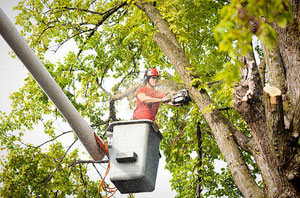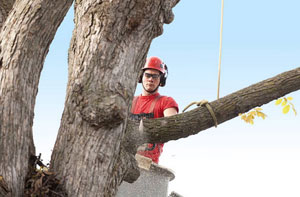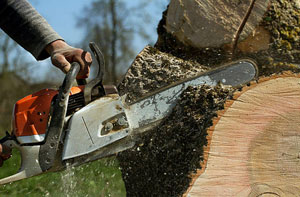Dunfermline Tree Surgeon Scotland: A crucial feature of many properties and gardens in Dunfermline, trees add substance, style and structure to what can quite often be a boring and two dimensional area. However, when trees are poorly maintained or are impacted by extreme weather events like flooding or high winds, issues may arise. Before any work commences, the safest option is to seek the guidance of a trained tree surgeon in Dunfermline, when your trees need looking at.
There's an enormous risk of damaging property, trees or even life, for those in Dunfermline who try to do tree work on their own, or by hiring a non-qualified person. However, tree work is not a safe undertaking, even for experienced tree surgeons, who are aware of all the risks. On average there are one hundred and forty serious injuries and three deaths per year within the industry, making it among the most dangerous jobs in Britain and definitely not for amateurs to attempt.

There is also a risk to life from damaged or neglected trees in Dunfermline, as around five people per year are tragically killed in the United Kingdom by falling branches and trees. You might be liable to third-party compensation claims as a consequence of your actions, if you employ somebody to do tree work and property is damaged, or an injury occurs. These are the reasons why it is important to employ a trained tree surgeon to do the work on your trees in Dunfermline. (The above figures were sourced from HSE UK).
There are 2 trade bodies that a qualified tree surgeon in Dunfermline should really be an approved member of. The membership and professional standing of any tree surgeon in Dunfermline can be checked out on the websites of both the International Society of Arboriculture and the Arboricultural Association. To find out if any specific tree surgeon has recognised ARB Approved Contractor status and has membership of either of these two bodies, you can check on this website.
If there's an issue during or after any tree work has been concluded you'll be able to get in touch with these trade bodies for mediation and for guidance and help at any point.

If someone offers you a quote for any tree work and you are unable to find them on this directory list, you should politely decline their offer of work and continue your search for an approved contractor. It is best to get a minimum of three quotes from different companies in the Dunfermline area, as soon as you have diligently checked their professional memberships and qualifications. Because of the risks involved in tree work, you should ask the questions below, stating you need a response:
- Can you provide me with a quotation in writing? You should only ever accept a written quote. NEVER accept a verbal quote only.
- Is It Possible To contact a recent person you've worked for so that I can assess the standard of your tree work? It's generally advisable to do an independent examination of recently completed work.
- Have you got documents to indicate that you've got the correct qualifications, membership of the AA or ISA, and also a certificate for basic chainsaw use from the NPTC/LANTRA? Any tree surgeon who uses a chainsaw, must by law have a NPTC/LANTRA certificate. Qualifications may include National Diplomas and Certificates in Arboriculture.
- Precisely what is your level of insurance cover? You should not even consider a tree surgeon in Dunfermline with less than £5 Million public liability insurance as recommended by the AA and ISA.
Clear and concise specifics of all the tree work that's to be undertaken must be included on the written quotation. Who is responsible for the removal of waste, tree branches and stumps should be stated, as should specifics of any trees which may be protected in law, and the steps needed to obtain permission to work on them. You should also ensure that VAT has been included on the quote unless you are a commercial entity. Realising that you have a responsibility to employ only qualified tradespeople to work on your trees and property, is vitally important.
PRIOR TO WORK BEGINNING - Making enquiries into the possibility of any of your trees having protected status, your selected Dunfermline tree surgeon should make sure that any work gets the go-ahead from the relevant local authority. Finding a tree has got protected status does not signify that work cannot be carried out, because even protected trees require maintenance in order to cut back dead or dying wood and ensure public safety.
No less than six weeks written notice must be given to the Local Planning Authority (LPA) before any tree work can be undertaken, if your property in Dunfermline is inside a conservation area. This is only required for trees with a trunk diameter of more than 75mm in diameter, at a point 1.5m above the ground. If the branches of a protected tree need thinning or pruning to promote and sustain growth, it's also not necessary to give written notice.

Your chosen Dunfermline tree surgeon will determine the remedial treatment needed and how the required outcome can be achieved with safety in mind after conducting a complete assessment of your trees health. Where there's any potential for falling debris and branches, a full risk assessment will need to be completed on your property, public areas, and parts of neighbouring properties that could be affected. This stage will also determine the level of protection required and the amount of workforce needed. This will include various safety precautions along with PPE to guarantee the safety of the general public and nearby property.
ON THE DAY OF WORK - Barriers and safety measures should be put in place before any tree felling, cutting of branches or climbing is started, to keep passers-by and unauthorised persons away from the area of work. When there's a chance of debris falling onto a road, it may be necessary to stop the traffic briefly.
Depending on the type of work required a tree surgeon will need different levels of protection. When working with a chainsaw, they will at a bare minimum be wearing protective clothing to prevent serious cutting injuries to the hands, legs and torso. Every operative involved in the work, should at all times be wearing head and eye protection, and high-vis clothing.
If any working at height is involved, ladders and associated climbing equipment will have to be used, and extra personnel will be on hand to help with the removal of high branches and large sections of tree trunk. A skip or other method of transporting the waste materials away will be parked as close to the work area as possible, so it's recommended that you inform your neighbours of the need for unhindered access.
AFTER COMPLETION OF WORK - Once the work has been completed all of the waste will be hauled away and the whole area cleared of any debris. Your tree surgeon should then put together and sign off a certificate of work, a copy of which will be handed to you. This is particularly important where trees with TPOs are concerned. If any public spaces required safety measures, this protection can be removed and footpaths and highways will be re-opened to the public.
If you have any issues or problems with the completed work, you should first address them with your tree surgeon so that they can be rectified immediately. If your tree surgeon is a member of a professional trade body, you can get help and advice from the AA or the ISA so as to arrive at a satisfactory conclusion, if any further arbitration is required.
Locally based Dunfermline tree surgeons are most likely have the phone code 01383 and the postcode KY11. They will operate in Dunfermline itself, together with nearby areas like Kingseat, Townhill, Hillend, Crossgates, Oakley, Crossford, Limekilns, Cairneyhall, Dalgety Bay, Blairhall, Hill of Beath, Inverkeithing, Valleyfield, Halbeath, Charlestown, Crombie, and these postcodes: KY11 4JR, KY11 2JD, KY11 3DH, KY11 3BB, KY11 3BA, KY11 4LB, KY11 4JX, KY11 4HU, KY11 3DB, KY11 3AW.
If you require this sort of assistance it's certainly a good idea to use an accredited tree surgeon. Dunfermline home and business owners can substantially benefit from the dexterity and skills offered by a fully trained professional.
Dutch Elm Disease
A fungal disease that has killed tens of millons of elm trees all over the UK over the last 50 years or more, Dutch Elm Disease (Ophiostoma novo-ulmi) is not quite as big a problem as it was previously. Caused by a fungus called Ophiostoma novo-ulmi which is spread by the elm bark beetle (particularly the Scolytus genus), DED (Dutch Elm Disease) was imported into the UK inadvertently in the late nineteen sixties from North America (Canada).
After arriving, it was spread swiftly through the movement of elm products like saplings, mulching bark, crates, and logs with the bark on. Believed to have originally come from Asia (probably Japan), Dutch Elm Disease didn't only affect trees in Great Britain, but also decimated elm stocks in mainland Europe and North America.
Usually first showing up in early summer, the recognisable signs of Dutch Elm Disease disease are:
- Twigs with spots or rings in cross-section.
- Clusters of leaves turning yellow, wilting and falling.
- A "shepherd's crook" reaction on affected twigs.
- Affected shoots dying back from the tips.
The chopping down of infected, dead and dying trees, has effectively decimated the elm bark beetle's favourite habitat, and in recent times the spread of DED has been slowed down. A project for the propagation of young elms that have so far proved resistant to Dutch Elm Disease is currently being undertaken.
You could ask for a diagnosis from the Tree Health Diagnostic and Advisory Service, or you can contact your local tree surgeon for guidance and advice, if you've got elm trees on your property in Dunfermline, and are suspicious they may be infected with Dutch Elm Disease.
(Tags: Dutch Elm Disease Dunfermline, Spotting Dutch Elm Disease, Signs of Dutch Elm Disease).Skills and Knowledge Needed by a Tree Surgeon in Dunfermline
- Be capable of repairing, maintaining and using tools and equipment.
- To be able to undertake basic tasks on a hand-held device or computer.
- Have an organised working approach.
- Have good customer service skills.
- The cabability to work efficiently with others.
- Be patient and have the ability to stay calm in times of stress.
- Be professional and capable of completing tasks within a set time frame.
- Have a good understanding of public security and safety.
- Be able to work with your hands.
- Be conscious of the complexities and dangers involved with the various aspects of the work.
- Physical skills like movement and co-ordination.
The Day to Day Duties of a Tree Surgeon
- Deal with clients and complete administration duties.
- Be adept with power tools and powered machinery.
- Establish dangers posed by trees.
- Prepare telephone or on-site quotes for clients.
- Assess the health of trees and formulate treatment plan.
- Produce tree survey reports for both domestic and commercial clients.
- Service equipment like chainsaws and chippers.
- Fell and remove trees and perform stump grinding.
- Climb trees to prune or remove branches as required.
- Tidy site upon completion and fulfil removal of waste product from customer's site.
- Plant trees and vegetation.
- Cut and chip logs and branches.
Tree Emergencies Dunfermline
Having to contact a tree surgeon for an emergency isn't something which is liable to happen very frequently, however if you've got sizeable trees in your Dunfermline garden, this might be a necessity at some time. When the weather conditions in Dunfermline are windy and stormy, tree surgeons typically expect to see a rise in emergency call outs, and thankfully many of them offer a 24/7 service for your peace of mind. Whilst the chances of an entire tree falling down are low, there is more potential for branches snapping off and tumbling to the ground below, when the weather conditions are gusty. Avoidance is definitely preferable to having to deal with the consequences, and common issues that can result from falling tree limbs and branches include splintered sheds, damaged fences, busted garden furniture and smashed greenhouses.
Of course, the local authorities in the Dunfermline area will also frequently need to call on emergency tree surgeons, when large branches fall onto public pavements, streets and railway tracks.
Further problems could also occur after the emergency tree surgery has been completed, because when a tree has lost some of it's larger limbs, it may appear lopsided, with the weight unevenly distributed - hence "re-balancing" might be required. If you are experiencing any of these tree related issues, you should not try to tackle any of them on your own, and you should immediately call up a local Dunfermline tree surgeon who offers emergency services, so they can advise on the preferred strategy. (Tags: Emergency Tree Surgery Dunfermline, Emergency Call-Outs Dunfermline, Emergency Tree Services Dunfermline, Tree Care Emergencies Dunfermline).
Protecting Shrubs and Trees in the Wintertime
Despite the fact that long periods of intense cold are quite rare in Dunfermline it could still be worthwhile to think about some measures for protecting your shrubs and trees when the weather turns sour. In actual fact, even trees, plants and shrubs that we normally think of as hardy, will benefit from a bit of added protection during the colder winter season.
Naturally where trees are involved it is high winds that can be the biggest problem and despite the fact that many trees will have shed their leaves by winter, they can still suffer damage in windy conditions. If you have a tree in your garden that appears to be weakened, or shows signs of toppling over, you'll need to have it inspected by a local tree surgeon, who'll offer advice and guidance. Heavy snow can also cause branches to snap, so stay alert when these sorts of weather conditions are expected. A deep layer of mulch round the base of shrubs and trees (particularly recently planted ones), will help in keeping the roots frost-free and preventing them from becoming dehydrated.
Logs & Firewood Dunfermline

If you are searching for firewood or logs in Dunfermline, tree surgeons are normally an excellent source for this particular commodity. As felling trees and chopping off branches is a major part of their daily routine, this is a natural sideline for the enterprising tree surgeon.
Some tree surgeons in and around Dunfermline may be prepared to let you have branches and logs free of charge, since they've always got loads of them to dispose of, whilst others will require paying for seasoned and chopped logs which have been dried out and are ready to burn.
Bunging "wet" logs on your wood burner or open fire is not a good idea, and will create lots of smoke and block up your flue. You should only use logs which have been dried out for at least twelve months and have a moisture content of 20 percent or lower. The advantage of getting logs from tree surgeons, is that these are likely to be mostly assorted hardwood logs, which will provide heat for several hours, and give a sustained burn. Softwood logs are superb for getting a fire started, therefore if you can get hold of some of these as well, that would be helpful.
Air-Spading Dunfermline
When you're worried about the overall health of a tree, it could be due to a number of problems, but issues with the root system is a common trigger for such worries. A qualified Dunfermline tree surgeon might need to get at a tree's roots to check for root rot, soil compaction, or other issues.
This was a difficult thing to achieve during the past, because in the digging down process, the roots of the tree could be easily damaged. Many contemporary tree surgeons in Dunfermline use a system known as "air spading", which employs compressed air to successfully break down and blow away compacted soil without the risk of damage to the tree's roots, or any utilities that happen to be nearby.
The soil surrounding tree roots can become compacted by foot traffic, passing vehicles or construction work, and this is known to have a negative impact on the general health of a tree. A tree can become "stressed" due to a lack of nutrients and water, which renders it more vulnerable to attack by pests, diseases and insects. Also a good technique for resolving root flare issues, air-spading can be used to remove the soil from the base of a tree which has become covered in an excess of soil, heightening the chance of root rot.
Involving the use of an air compressor and an air-spade, the air-spading process blows high-speed air into the soil, this breaks it up by penetrating spaces in the soil, but has no effect on the tree roots or nearby utilities. As compacted soil is directed away from the tree's roots by the powerful air flow, immediate inspection can be accomplished. A resolution can then be found for any any obvious problems, and the previously compact soil replaced with a looser layer of wood mulch and fertiliser to help encourage the tree to revive. (Tags: Air-Spade Investigations Dunfermline, Air-Spading Dunfermline, Air-Spade Dunfermline).
Ash Dieback (Hymenoscyphus Fraxineus)
A deadly fungal disease affecting ash trees, that was first reported in the UK in 2012, ash dieback (Hymenoscyphus fraxineus) is likely to wipe out approximately 80% of the current ash tree stock. Having a similarly calamitous effect on the British countryside as Dutch Elm Disease, ash dieback is just another setback for the United Kingdom's tree stocks.
Ash dieback has a particularly disastrous effect on the native British common ash (Fraxinus excelsior), although it affects the entire Fraxinus genus of trees, which have varying levels of tolerance to it. Originating in Asia, the fungus which causes the disease is named Hymenoscyphus fraxineus.
Dispersed by tiny spores that blow on the wind, which can travel for tens of miles, ash dieback (or chalara ash dieback as it is often known) has already spread to most regions of Britain.
Ash dieback can be recognised by the following symptoms:
- Leaves that wilt, turn black and fall early.
- The formation of lesions where branches connect to trunk.
- New epicormic growth appears from previously dormant buds.
- Leaves and new shoots which are dying during the growing season.
- Leaves with dark patches that appear during the summertime.
Sometimes ash trees are able to resist early infections, but as the disease returns year after year, they eventually succumb. There's presently no remedy for ash dieback, and no clear-cut strategy for stopping it spreading.
Whilst the "Tree Alert Service" provided by the Forestry Commission is currently only interested in hearing about reports of cases in new locations where ash dieback hasn't previously been recorded, if you're concerned about an ash tree in your garden in Dunfermline, you should call in a local tree surgeon to affirm the diagnosis and suggest a suitable solution.
(Tags: Identifying Ash Dieback, Ash Dieback Signs, Chalara Ash Dieback Dunfermline).Storm Damaged Trees Dunfermline
Of all the living things in our gardens, trees appear to be the strongest, sturdiest and the most able to stand up to the vagaries of Mother Nature. Certain types of trees can in actual fact live and continue to grow for several hundred years and will happily do so in most circumstances.
Having said that, they can be quite susceptible to the elements when faced with a certain set of conditions, and it is not only the risk of falling branches or limbs, but in extreme circumstances the whole tree can crash to the ground. The main weather related problem for trees is high winds, and as the number of violent weather events and storms in Dunfermline increases because of climate change, this form of damage is becoming more common. Heavy snow during winter can also cause issues, as can saturated soil resulting from flooding or extended periods of rainfall.
To lessen the chance of problems with your trees in severe weather conditions, it's advisable to get a certified Dunfermline tree surgeon to check them out every so often, and prune any dead, dying or excessively long branches.
Lightning rods, copper conductors, or other lightning protection systems are also recommended for taller trees, to lower the chances of them being struck by lightning and to safeguard nearby buildings and property which might be vulnerable to side-flashes ("jumps") that result in more destruction, in addition to damage done to the tree itself. A tree can be killed or severely weakened when it is struck by lightning, and even where the damage isn't immediately obvious, the tree will likely be more susceptible to attacks by disease and pests. You might not imagine that lightning strikes are all that common, however in the UK there are around 300 thousand lightning strikes recorded each year.
If you're anxious about the risk of your trees in Dunfermline being damaged by storms, you should ask your local tree surgery company what they can do to safeguard them, and lessen the risk of mishaps occurring. (Tags: Storm Damage Dunfermline, Storm Damage Prevention Dunfermline, Storm Damaged Trees Dunfermline).
The Use of Chainsaws

The most commonplace piece of equipment that professional tree surgeons in Dunfermline use is the chainsaw. It is a versatile and effective tool, but can be very dangerous in the wrong hands. Petrol powered chainsaws are the most preferred by professionals, because of their ease of use and greater portability, although mains versions can be purchased, as can rechargeable battery chainsaws which have become popular for some operations. Where thick limbs and large trunks need cutting, such heavy tree work necessitates the use of the most robust petrol chainsaws.
A chainsaw is composed of a motor and a rotating chain with a series of sharp teeth which cut through the bark and wood of a tree. For the different functions they perform, there are various types of chainsaw, top-handled for working at height (and which can be operated with one hand if required), pole saws for hard to reach branches and long distance pruning and rear-handled for work at ground level (must be used with two hands).
You'll seldom find a professional Dunfermline tree surgeon who doesn't use a chainsaw, although clambouring up a tree with a spinning blade in your hand is not isn't the safest thing to be doing. One of the main requirements for membership of the Arboricultural Association, is that tree surgeons need to be trained in the safe use of chainsaws.
For any individual interested in purchasing a chainsaw in Dunfermline, there are many brands on the market, however the most preferred by tree care professionals are Hyundai, Makita, Husqvarna and Stihl.
Tree Surgery Tasks Dunfermline

Dunfermline tree surgeons can usually help you with tree removal, tree planting, tree fertilising, crown thinning, the protection of trees from grazing animals, tree reduction Dunfermline, tree felling, coppicing in Dunfermline, tree inspections, tree pruning Dunfermline, crown cleaning Dunfermline, tree reshaping, crown removal, stump treatment in Dunfermline, hazard assessment in Dunfermline, crown reduction, pest management, waste removal in Dunfermline, tree surveys Dunfermline, residential tree surgery Dunfermline, eco-plugging, brush cutting Dunfermline, hedge lowering, tree watering, staking Dunfermline, tree lopping, tree lightening protection, tree waste removal, hedge reduction, safety inspections and other tree surgeon services in Dunfermline, Scotland. These are just a selection of the tasks that are handled by a tree surgeon. Dunfermline specialists will tell you about their full range of services.
Tree Surgeons Nearby
Also find: Crombie tree surgeon, Kingseat tree surgeon, Valleyfield tree surgeon, Limekilns tree surgeon, Blairhall tree surgeon, Hill of Beath tree surgeon, Hillend tree surgeon, Crossgates tree surgeon, Charlestown tree surgeon, Cairneyhall tree surgeon, Crossford tree surgeon, Townhill tree surgeon, Halbeath tree surgeon and more. All these villages and towns are covered by tree care companies. Property owners in these places can acquire tree surgery quotes by going here.
Tree Care Services Dunfermline
- Dunfermline Tree Pruning
- Dunfermline Root Decompaction
- Dunfermline Tree Management
- Dunfermline Stump Removal
- Dunfermline Root Grinding
- Dunfermline Crown Removal
- Dunfermline Tree Topping
- Dunfermline Tree Reduction
- Dunfermline Shrub Maintenance
- Dunfermline Tree Pollarding
- Dunfermline Tree Dismantling
- Dunfermline Tree Planting
- Dunfermline Wood Chipping
- Dunfermline Tree Bracing
More Dunfermline Trades: Obviously, when you are having tree surgery done in Dunfermline, Scotland, you will likely need other garden related services, and apart from a tree surgeon in Dunfermline, Scotland, you may also need patio cleaning in Dunfermline, hard landscaping in Dunfermline, garden shed installation in Dunfermline, hedge trimming in Dunfermline, garden planning and design in Dunfermline, garden clearances in Dunfermline, waste removal in Dunfermline, pond installers in Dunfermline, soil irrigation in Dunfermline, decking specialists in Dunfermline, fencers in Dunfermline, garden digging services in Dunfermline, grass cutting services in Dunfermline, artifical grass in Dunfermline, SKIP HIRE in Dunfermline, block paving in Dunfermline, and other different Dunfermline tradespeople.
 Tree Surgeon Dunfermline
Tree Surgeon Dunfermline Tree Surgeons Dunfermline
Tree Surgeons Dunfermline Tree Surgery Dunfermline
Tree Surgery DunfermlineTree Surgeon Jobs Dunfermline: Find Dunfermline tree surgeon jobs here: Tree Surgeon Jobs Dunfermline
If you're interested in local Dunfermline info look here
Tree Surgery KY11 area, 01383.
TOP - Tree Surgeon Dunfermline
Tree Surgeons Dunfermline - Arboriculturalist Dunfermline - Stump Removal Dunfermline - Tree Felling Dunfermline - KY11 - Vegetation Management Dunfermline - Tree Surgeon Dunfermline - Tree Management Dunfermline - Forest Management Dunfermline





